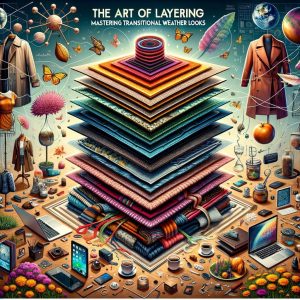“The Art of Layering: Mastering Transitional Weather Looks”
As the seasons shift and the weather becomes an ever-changing tapestry of warm sun and brisk breezes, the challenge of dressing appropriately can feel daunting. Enter the art of layering—a skill that not only allows us to adapt to fluctuating temperatures but also offers an opportunity for creative expression through fashion. In this guide, we will explore the nuances of layering, from selecting the right materials and colors to mastering the balance between comfort and style. Whether you’re navigating the unpredictable days of early spring or the cool evenings of late fall, understanding the principles of layering will empower you to curate outfits that are as versatile as they are chic. Join us as we delve into this essential aspect of transitional weather looks, where practicality meets creativity in the realm of personal style.
Finding Balance: Key Principles of Layering Essentials
Achieving a well-balanced outfit during transitional weather is an art that hinges on strategically layering your essentials. Start by selecting foundation pieces that serve as the backbone of your ensemble. These should be versatile, breathable, and comfortable, allowing for easy adjustments as the weather changes. Think of materials like cotton or merino wool for base layers, which maintain warmth without overheating. Consider the following essential components to build from:
- Lightweight tops: T-shirts or long-sleeve shirts for initial warmth.
- Mid-layer options: Cardigans or lightweight sweaters for added insulation.
- Outerwear: A stylish yet functional jacket or coat to shield against the elements.
To elevate your look, pay attention to color, texture, and silhouette when layering. A harmonious blend of these elements not only adds depth to your outfit but also enhances your overall aesthetic. Aim to mix and match various textures, such as pairing a soft knit with a structured jacket. Don’t forget about accessories, as they play a crucial role in elevating layered looks. A chic scarf or a statement belt can tie everything together, ensuring your outfit is cohesive and stylish. Here’s a simple table to visualize a recommended layering combination:
| Layer Type | Material | Function |
|---|---|---|
| Base Layer | Cotton | Breathability |
| Mid Layer | Wool Blend | Insulation |
| Outer Layer | Water-Resistant Fabric | Protection |
Textural Harmony: Mixing Fabrics for Depth and Comfort
In the realm of fashion, the marriage of different fabrics can create an unexpected but delightful complexity to your outfits. Consider combining textures like soft cotton with sleek leather or cozy knits paired with a structured wool. These combinations not only add visual interest but also enhance comfort, making each layer even more inviting. The key is to find balance; mixing heavy and light materials can create a stunning juxtaposition, allowing you to play with contrast and cohesion. For instance, you might layer a soft flannel shirt under a rugged denim jacket, while incorporating a silky scarf that adds movement and elegance.
To expertly blend these fabrics, focus on a cohesive color palette that ties different textures together. This unification creates a harmonious look that feels intentional rather than chaotic. When layering, pay attention to the weights and drapes of the materials to ensure they work together seamlessly. A simple approach might include:
- Base Layer: Lightweight cotton or moisture-wicking fabric
- Middle Layer: Slightly heavier knits or terry cloth
- Outer Layer: A durable coat or a structured blazer
By experimenting with these combinations, you can develop a rich wardrobe that feels rich in texture and inviting in feel, perfect for navigating the unpredictable nature of transitional weather.
Color Coordination: Creating a Cohesive Transitional Palette
When it comes to dressing for transitional weather, achieving a seamless look is all about color coordination. To tie your outfit together, consider selecting a palette that reflects both the season and your personal style. This can involve choosing a dominant color and then incorporating a couple of accent shades. For example, a base of earthy greens or muted mustards can be beautifully complemented by rich navy or soft pastels. Key points to keep in mind include:
- Complementary Colors: Select colors that enhance each other to create visual harmony.
- Layering Versatility: Choose shades that can easily transition from one layer to another, allowing flexibility in your ensemble.
- Accessorize with Care: Use accessories to pop colors without overwhelming the look.
Creating a well-coordinated look also involves considering texture and pattern alongside your color choices. Each layer should not only align in hue but also in the materials used. Think about mixing fabrics like a soft knit sweater with a structured denim jacket; this adds intrigue while maintaining cohesiveness. A simple table can help visualize your layered combinations:
| Layer | Color | Texture |
|---|---|---|
| Base Layer | Light Beige | Cotton |
| Mid Layer | Olive Green | Knit |
| Outer Layer | Deep Navy | Denim |
By thoughtfully selecting your colors and textures, you can masterfully navigate the challenges of transitional dressing. The key is to embrace variety while ensuring that all elements feel intentional and connected.
Accessorizing Smartly: Elevating Layered Looks with Thoughtful Details
When it comes to layering, the magic often lies in the details. Opt for statement accessories that can enhance your overall look while adding functionality. A chunky scarf can not only provide warmth but also serve as a colorful focal point. Consider earrings that dangle or intricate necklaces that can peek out from under a collared shirt. Each piece should work in harmony with your layers, rather than compete for attention. Here are some ideas to get you started:
- Bold Belts: To cinch oversized outerwear or dresses and define your silhouette.
- Layered Necklaces: For a throwback to the ‘90s vibe, mixing different lengths and textures can be striking.
- Interactive Bags: Choose bags with functional elements like pockets or straps that can easily be adjusted.
- Wristwear: Stack different bracelets for an eclectic look that draws the eye.
Furthermore, the choice of materials and colors plays a significant role in how well the accessories elevate your layered outfits. Metallics can provide a sleek contrast against cozy fabrics, while natural elements like wood or stones can add earthiness. In transitional weather, it’s wise to think utility alongside aesthetic; thus, ensuring your accessories align with the climate can boost comfort levels. Below is a simple guide to select color palettes for your accessories:
| Layer Color | Recommended Accessory Color |
|---|---|
| Neutral Tones | Earthy Greens or Deep Blues |
| Warm Hues | Rich Golds or Creams |
| Cool Shades | Soft Pinks or Metallic Silvers |
In Conclusion
As we transition through the seasons, the art of layering emerges as a powerful tool in our style arsenal. It not only offers practicality in navigating unpredictable weather but also provides a canvas for personal expression. By thoughtfully combining textures, colors, and silhouettes, you can curate outfits that reflect your unique taste while ensuring comfort and versatility. Embrace the challenge of layering—not just as a way to stay warm or cool, but as an opportunity to showcase your creative flair. With these strategies in hand, step confidently into the ever-changing climate, knowing that each layer tells a part of your story. Happy layering!













Post Comment